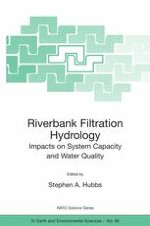
2006 | OriginalPaper | Buchkapitel
Use of Aquifer Testing and Groundwater Modeling to Evaluate Aquifer/River Hydraulics at Louisville Water Company, Louisville, Kentucky, USA
verfasst von : Dave C. Schafer
Erschienen in: Riverbank Filtration Hydrology
Verlag: Springer Netherlands
Aktivieren Sie unsere intelligente Suche, um passende Fachinhalte oder Patente zu finden.
Wählen Sie Textabschnitte aus um mit Künstlicher Intelligenz passenden Patente zu finden. powered by
Markieren Sie Textabschnitte, um KI-gestützt weitere passende Inhalte zu finden. powered by
In 1999, the Louisville Water Company completed construction of a radial collector well adjacent to the Ohio River in Louisville, Kentucky at their B. E. Payne Water Treatment Plant. The well was completed in a sand and gravel aquifer to a depth of 105 feet as part of a pilot study to evaluate the feasibility of converting their surface water supply to riverbank infiltration. One of the objectives of the study was to estimate the total yield capacity available along the shoreline on the Payne Plant property. It was hoped that the supply developed at this location could supply 25 percent or more of the water company’s requirement of 240 million gallons per day.
Beginning in August 1999, a 70-day constant-rate pumping test was conducted on the well to evaluate aquifer properties. The parameters of interest included aquifer transmissivity, leakance between the Ohio River and the aquifer, and vertical anisotropy ratio of the aquifer sediments. The aquifer coefficients determined from the pumping test were applied in a groundwater flow model to predict yields of various extraction facilities designs for the site.
Three design options were considered for the Payne Plant site. One design incorporated two or more new collector wells in addition to the pilot well, connected by a subterranean tunnel drilled in the shale and limestone bedrock beneath the sand and gravel aquifer. The second option was to install a large diameter tunnel within the sand and gravel aquifer and extend well screen laterals from the tunnel to produce water. The third option was to drill conventional vertical wells, but connect them to a subterranean tunnel drilled in the bedrock.
Modeling showed that all three of the design options could produce the desired yield. This meant that the design and construction decision could be driven by the economics of the project. Modeling was used further to track the decline in yield of the pilot collector well over time caused by clogging and compaction of the riverbed sediments. Modeling showed average riverbed leakance reductions of approximately an order of magnitude.